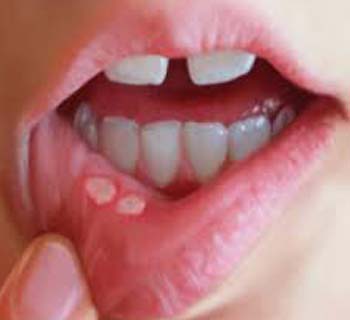Medicines

Oral problems
In Medicines
Bookmark
Record learning outcomes
Mouth ulcers, teething and toothache can all be managed with OTC medicines. But pharmacy staff must be aware of how to use these products effectively and safely, as Alan Nathan explains
 Mouth UlcersÂ
Mouth UlcersÂ
(Recurrent Aphthous Stomatitis)
The cause of mouth ulcers is unknown and treatment can only be symptomatic. A wide range of approaches and products is available. Evidence of their effectiveness is sparse, but a Cochrane review is currently being undertaken.1
 Hydrocortisone sodium succinate
- Hydrocortisone is a naturally occurring glucocorticoid. Corticosteroids are widely used as topical anti-inflammatory agents. As mouth ulcer tissue is intensely inflamed, corticosteroids should be be helpful.
- Presented as small muco-adhesive tablets, licensed for use in adults and children over 12 years (under 12 on medical advice only; not recommended in pregnancy).
- One tablet placed in the mouth close to the ulcer(s) and allowed to dissolve slowly, up to four times a day for a maximum of five days. This presentation is useful when ulcers are situated between the gum and cheek or beneath the tongue, but may be difficult to maintain in position elsewhere.
- There appears to be no published clinical evidence for its effectiveness.
Benzydamine hydrochloride
- A non-steroidal anti-inflammatory and analgesic drug, available as an oral rinse and spray, both containing 0.15% benzydamine hydrochloride. As a solution, it can reach areas inaccessible to other ulcer treatments.
- For adults, 15ml rinse should be used every 1.5 to three hours for up to seven days. If stinging occurs, the solution may be diluted with water. The rinse is not suitable for children under 12 years of age.
- The oral rinse has been shown to be effective in the treatment of some oral inflammatory conditions. However, there is poor evidence of its effectiveness against mouth ulcers, although in two small trials it provided some pain relief.2,3
HybenX
- A strongly keratolytic and hygroscopic patented formulation of a concentrated aqueous mixture of hydroxybenzenesulphonic acid, hydroxymethoxybenzene sulphonic acid and sulphuric acid. It is licensed as a medical device and used in dentistry as a root canal cleanser. In treating mouth ulcers its manufacturers claim that it selectively removes dead or damaged tissue, and then creates a seal over the site to aid healing and provide pain relief.
- Supplied as a treatment stick, applied for a few seconds after first drying the area with a cotton bud.
- A single application should normally suffice.
Should not be used for children under age 12, or during pregnancy. - A clinical trial of HybenX versus another dental hydrogel product concluded that it safely and effectively reduced the painful symptoms of mouth ulcers.4 In a comparative trial against a triamcinolone in Orabase formulation, patients subjectively reported significantly greater relief from symptoms with the HybenX preparation.5
Gel-based treatments
- Products containing polymers such as polyvinylpyrrolidone (PVP, povidone) and cellulose form a film over ulcers, acting as a protective barrier.
- They are classed as medical devices.
Other treatments
- A wide range of products in the form of gels, paints, pastilles and mouthwashes, most of which contain combinations of two or more of anaesthetic, analgesic, antimicrobial and astringent ingredients.
- Many formulations are aqueous or aqueous–alcoholic liquids or gels, which would be diluted fairly rapidly and washed away from the site of application by saliva, requiring frequent re-application.
- Pastilles or sore throat lozenges containing local anaesthetics, placed against lesions and allowed to dissolve, may produce a more prolonged effect.
- Some lozenges containing higher concentrations of local anaesthetic are unsuitable for children. Products containing salicylic acid or salicylates should not be used in children under 16 years, due to the possibility of Reye’s syndrome.
Toothache
- Toothache is not a symptom of a self- limiting condition and requires referral in all cases, but analgesics can be recommended in the meantime.
- NSAIDs are in theory the most effective analgesics for dental pain (a full review of OTC oral analgesics was provided in August and September articles).
- Eugenol is the active constituent in clove oil, which has an analgesic and local anaesthetic effect. It is indicated for pain caused by a dental cavity. It should be applied directly to the affected tooth, two- hourly if necessary. It may cause irritation to surrounding tissues if not applied accurately.
- A gel containing benzocaine 20% is marketed specifically for acute toothache caused by a broken tooth or dental cavity, for adults and children over 12 years.
Teething
- One liquid preparation containing lidocaine at low strength (0.9%) is licensed for treatment of teething.
- Several proprietary gels, containing low concentrations of local anaesthetic and antimicrobials, are available.
- One product consists of powders containing tincture of matricaria, extracted from German chamomile flower heads; chamomile has been used traditionally as an analgesic and anti-inflammatory. It contains matricine and alpha-bisabolol, which exert these actions. Powders may be given to infants aged over six months.
Oral thrush(Candidiasis)
- Candidiasis is an infection caused by a yeast-like fungus. It is treated with miconazole 2% oral gel, licensed for use in adults, children and babies from age four months.
- It interacts with drugs metabolised via CYP3A4 and CYP2C9 enzyme systems; it is contraindicated with the former and should be used with caution with the latter.
- It is possibly fetotoxic and should only be supplied to pregnant women against prescription.
GINGIVITIS
- Chlorhexidine digluconate, an antimicrobial effective against a wide range of bacteria, yeasts and fungi, is available as a 0.2% mouthwash and spray and a 1% gel, for inhibition of the formation of dental plaque and in the treatment and prevention of gingivitis.
- Hexetidine, another broad-spectrum antimicrobial, available as a 0.1% mouthwash, is also indicated as an aid in the prevention and treatment of gingivitis.
References available from the editor on request
Â
